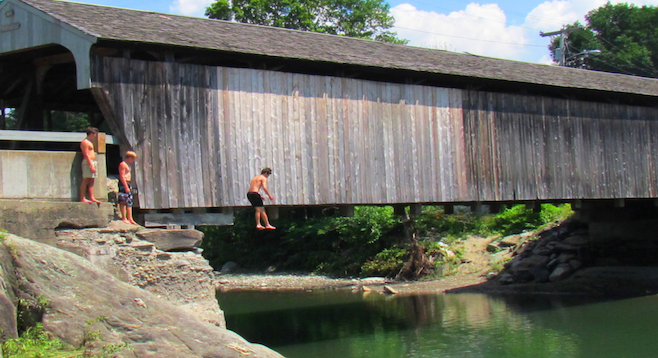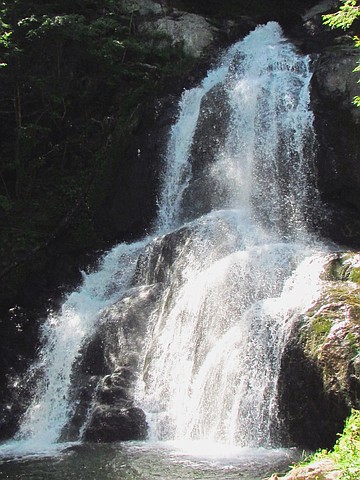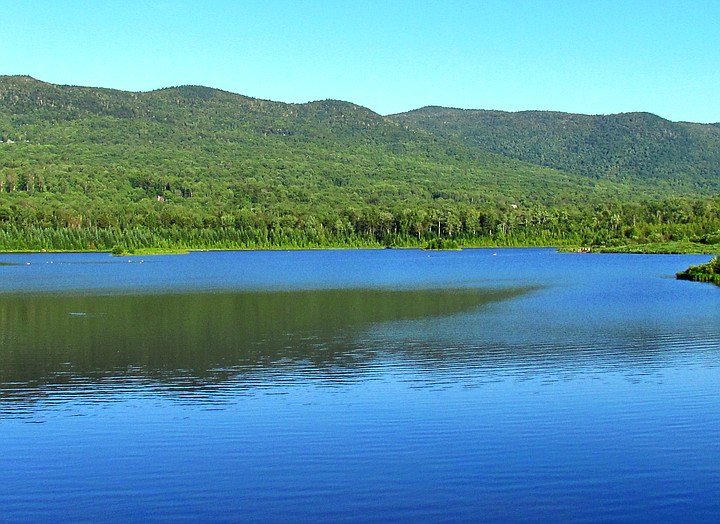 Facebook
Facebook
 X
X
 Instagram
Instagram
 TikTok
TikTok
 Youtube
Youtube

Not much changes in Vermont aside from the height of the trees. The second-least populated place in the country, the Green Mountain State is well known as a snowy winter wonderland and for its scenic autumn foliage and maple syrup. But, surrounding its small colonial villages, tucked into the nooks beneath looming conifer-covered mountains are numerous swimming holes providing old-time relief from the heavy East Coast summertime humidity.
About 500 million years ago Vermont was in the tropics. Today, it’s the only New England state not bordering the Atlantic. Bordered on the west by Lake Champlain and with an annual average of 50 inches of precipitation a year, Vermont hardly suffers from a shortage of water.

Seven majestic natural lakes and four reservoirs were gouged out of the rock by glaciers. There are 16 rivers and numerous smaller tributaries flowing throughout the state and a pond around every bend. There are more than 70 waterfalls and cascades, and 46 swimming holes – many being protected by local nonprofits such as the Vermont River Conservancy.
Because dipping into these natural pools – many of which are located on private property – is inherently dangerous, and because people drown in them regularly, caution is advised. As in other water bodies, deaths occur mainly in areas with strong currents and when folks are diving and/or drinking. Also, be forewarned that skinny dipping is part of the whole natural wet ‘n wild scene. The further out the spot, the more probable the nudity.
That said, waterholes are diverse in style and hazard potential. One of the more distinctive spots is the favored Bolton Potholes just north of Camel’s Hump. They're a series of terraced bowls carved out of massive boulders and connected by waterfalls. Others are in abandoned quarries.
Others are gorges in fast-pounding rivers with aggressive rapids. More than twenty people have died in the gorgeous Huntington River Gorge since 1960 alone, including a state police diver who drowned while trying to retrieve a victim. A classmate of mine from college was even sucked down into the undertow. Yet, such statistics don’t seem to deter the tens of thousands of people who venture into Vermont’s waterways each year.
The 10 pools in the centrally situated Mad River area are as diversified. Beneath slope-scarred Sugarbush Mountain the Moretown Gorge with its deep swirling waters can be treacherous and so is only recommended for strong, experienced swimmers. The swimming holes at the Warren and Waitsfield (top) covered bridges are slow, shallow, family-friendly pools equipped with beaches and good old-fashioned rope swings. The clothing-optional Punchbowl is hugely popular, as is Warren Falls (left). And just uphill from the Warren Country Store is serene Blueberry Lake.

This 48-acre man-made reservoir, once an overgrown meadow where cows and deer grazed, is now a popular alpine lake surrounded by hiking, biking and cross-country ski trails. Non-motorized watercraft is allowed, but that doesn’t thwart clusters of avid multi generational swimmers.
The rapids on the White River attract canoes and kayakers, too, but are also a hotspot for tubers.
There’s a reason folks endure the long frigid winters, unpaved rutted roads and hordes of hungry unrelenting gnats. It should say something that the vocal Von Trapp clan tucked tail and ran from the Nazis crossing the Alps only to settle in Stowe. The rebel Russian Solzhenitsyn chose Cavendish. I, myself, spent a decade along the banks of Lake Champlain watching the sun set over the Adirondacks and another on Magic Mountain before embarking for sunnier, milder climates.
But every time I return to Vermont, I'm drawn back to its gurgling waterways found flowing through ferned forests and over mossy ledges.


Not much changes in Vermont aside from the height of the trees. The second-least populated place in the country, the Green Mountain State is well known as a snowy winter wonderland and for its scenic autumn foliage and maple syrup. But, surrounding its small colonial villages, tucked into the nooks beneath looming conifer-covered mountains are numerous swimming holes providing old-time relief from the heavy East Coast summertime humidity.
About 500 million years ago Vermont was in the tropics. Today, it’s the only New England state not bordering the Atlantic. Bordered on the west by Lake Champlain and with an annual average of 50 inches of precipitation a year, Vermont hardly suffers from a shortage of water.

Seven majestic natural lakes and four reservoirs were gouged out of the rock by glaciers. There are 16 rivers and numerous smaller tributaries flowing throughout the state and a pond around every bend. There are more than 70 waterfalls and cascades, and 46 swimming holes – many being protected by local nonprofits such as the Vermont River Conservancy.
Because dipping into these natural pools – many of which are located on private property – is inherently dangerous, and because people drown in them regularly, caution is advised. As in other water bodies, deaths occur mainly in areas with strong currents and when folks are diving and/or drinking. Also, be forewarned that skinny dipping is part of the whole natural wet ‘n wild scene. The further out the spot, the more probable the nudity.
That said, waterholes are diverse in style and hazard potential. One of the more distinctive spots is the favored Bolton Potholes just north of Camel’s Hump. They're a series of terraced bowls carved out of massive boulders and connected by waterfalls. Others are in abandoned quarries.
Others are gorges in fast-pounding rivers with aggressive rapids. More than twenty people have died in the gorgeous Huntington River Gorge since 1960 alone, including a state police diver who drowned while trying to retrieve a victim. A classmate of mine from college was even sucked down into the undertow. Yet, such statistics don’t seem to deter the tens of thousands of people who venture into Vermont’s waterways each year.
The 10 pools in the centrally situated Mad River area are as diversified. Beneath slope-scarred Sugarbush Mountain the Moretown Gorge with its deep swirling waters can be treacherous and so is only recommended for strong, experienced swimmers. The swimming holes at the Warren and Waitsfield (top) covered bridges are slow, shallow, family-friendly pools equipped with beaches and good old-fashioned rope swings. The clothing-optional Punchbowl is hugely popular, as is Warren Falls (left). And just uphill from the Warren Country Store is serene Blueberry Lake.

This 48-acre man-made reservoir, once an overgrown meadow where cows and deer grazed, is now a popular alpine lake surrounded by hiking, biking and cross-country ski trails. Non-motorized watercraft is allowed, but that doesn’t thwart clusters of avid multi generational swimmers.
The rapids on the White River attract canoes and kayakers, too, but are also a hotspot for tubers.
There’s a reason folks endure the long frigid winters, unpaved rutted roads and hordes of hungry unrelenting gnats. It should say something that the vocal Von Trapp clan tucked tail and ran from the Nazis crossing the Alps only to settle in Stowe. The rebel Russian Solzhenitsyn chose Cavendish. I, myself, spent a decade along the banks of Lake Champlain watching the sun set over the Adirondacks and another on Magic Mountain before embarking for sunnier, milder climates.
But every time I return to Vermont, I'm drawn back to its gurgling waterways found flowing through ferned forests and over mossy ledges.
Comments